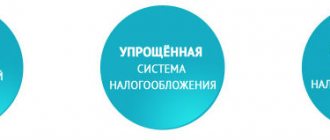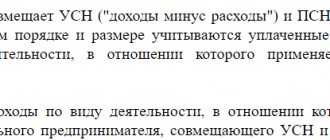When planning a business, an entrepreneur must take into account all factors influencing the final financial result. Taxes often account for a large share of the cost of goods and services. To reduce the tax burden, it is important to choose the tax system wisely.
Let us consider the relevance of the issue using the example of such a type of activity as retail trade, for which taxation systems can be of 5 types: patent, simplified, basic, single tax on imputed income and single agricultural tax.
BASIC
All taxpayers who have not declared a transition to a special tax regime in the manner and within the time frame established by law are, by default, payers of the general taxation system (hereinafter referred to as OSNO). This tax calculation scheme is considered the most labor-intensive, because provides for the payment of the following tax payments to the budget:
- corporate income tax (20%);
- VAT (base rate – 18%);
- property tax (from 1.5 to 2.2%);
- transport tax;
- land tax;
- Personal income tax (13% of payments accrued in favor of employees).
Retail trade on OSNO is unprofitable, costly and requires the accountant to spend a lot of time on record keeping. Most often, the general taxation scheme is used by wholesale trade networks, forced to do so due to legal requirements.
The advantage of OSNO is the ability not to transfer income tax to the budget in the event of a loss in the tax period. In addition, the company can adjust the financial result of the next year for losses incurred in previous years.
Transition to simplified tax system
There is no upper limit for individual entrepreneurs. In this case, you need to wait until the beginning of the reporting period, namely next year. The notification to the Federal Tax Service is sent before December 31 of the current year.
A transition to a simplified tax before the start of a new period is possible in the following cases:
- Newly registered organizations have the right to choose the simplified tax system, which is notified to the Federal Tax Service during registration or within a month after it.
- The entrepreneur stopped engaging in activities that allowed the use of a single regime, as a result of which he automatically switched to the simplified tax system.
- The indicators required by the single tax were exceeded, which also allows you to send an application for a simplified regime.
On video: Accounting IP USNO 6% for dummies What to pay and where? Where can I get the details?
USNO
Retail trade on the simplified tax system is not available to all companies - there are restrictions on revenue, organizational issues, the cost of fixed assets and the number of full-time employees. In addition, Article 346.12 of the Tax Code of Russia contains a list of types of activities for which simplified taxation is not available (including banking institutions, insurance organizations, pawnshops, manufacturers of excisable goods, and some others).
Simplified taxation in retail is very popular; this regime allows you to save significant amounts of income received and reduce the volume of accounting documentation. You cannot switch from the simplified tax system to another tax regime before the end of the current year; the manager must remember this when choosing this system.
Simplified legislation provides for 2 options for determining the taxable base and, accordingly, the amount of tax:
- 6% on income received by the organization;
- 15% of the difference between the revenue received and the organizational costs to obtain it. Not all types of costs can reduce revenue. If a loss is incurred, the company will still have to pay a minimum tax to the budget (1% of income). The concept of minimum tax on the simplified tax system “Income” does not exist, in other words, there is no income, there is no amount to be transferred to the budget.
It is the second option for determining the tax base that is beneficial for retail trade enterprises - all transport, utility, business costs, labor costs, etc. can be included in the expenditure part. Retail trade of an LLC on a simplified basis brings higher income compared to OCH.
If a company loses the right to use the simplified tax system during the tax period (excess of revenue, increase in the average headcount, etc.), it is automatically transferred to the general taxation system.
Rates
There are two types of simplified tax on wholesale trade, and you should decide on them in advance, since they can only be changed starting next year. They have different bet sizes. It is advisable to choose the Income-Expense simplified tax system if the company’s expenses exceed 60% of turnover. Documentary confirmation is required, which makes this mode unsuitable for online stores.
| USNO mode | Accrual | Rate (specific value is set by regional authorities) |
| Income | It is made from the total income of the entrepreneur minus insurance premiums (but not more than 50%). An individual entrepreneur without employees can reduce the taxable amount by up to 100%. | 0–6% |
| Income-Expenses | Net profit is taken into account, that is, expenses incurred by the entrepreneur are deducted from income. These include employee salaries, but not payments to the pension fund. | 5–15% The payment amount cannot be lower than the minimum amount of the simplified tax system, which is 1% of total income. That is, the minimum amount will have to be paid even if the company suffers losses. |
Simplified tax can be combined with:
- a single regime;
- patent tax system.
On video: Tax holidays for individual entrepreneurs on the simplified tax system and patent
UTII
Retail trade on UTII is the optimal solution for small companies. At one time there were active discussions about the abolition of imputation, but there is no consensus on this issue and the special regime is in effect until 2018. The disadvantage of UTII is that not all trading enterprises can apply it (restrictions on area, number of vehicles, type of activity and some other indicators).
The UTII rate is 15%. Imputed income is determined by multiplying the amount of basic profitability (each type of activity has its own), a physical indicator, the calendar time of application of the special regime and 2 coefficients. One coefficient is the deflator, set by the government. The second coefficient is set by local authorities, taking into account the attractiveness and profitability of business types.
Is it possible to carry out retail trade while remaining on the general regime?
The system can be applied without giving notice of the start of its use. OSN is characterized by conditions that complicate the conduct of activities along with positive aspects.
The negative aspects of using OSN include:
- Complete document flow of income and expenses. It is necessary to maintain tax registers for all expense transactions and all primary accounting documentation. Additional staffing units are hired to maintain records.
- The need to pay VAT. The tax is allocated in the receipt from the amount of the price of the goods by calculation.
- The obligation to pay property tax, provided that the property is involved in generating income from business activities. If an individual entrepreneur owns commercial real estate used for trading, property tax is payable.
- The need to use a cash register (cash register) for calculations. The individual entrepreneur must purchase equipment in accordance with the register of approved CCPs, enter into a service agreement and register the EKLZ (electronic control tape).
The obligation to use cash registers also arises in the case of accepting payments through electronic acquiring systems. The buyer has the right to choose the type of payment and receive a cash receipt.
The positive aspects of OSN when carrying out trading activities are:
- The ability to take into account the expense side of transactions when determining the taxable base when paying personal income tax.
- Expanding the circle of consumers. An individual entrepreneur can successfully conduct wholesale and retail trade without creating separate accounting. Additional opportunities for consumers are provided by the tax obligation to pay VAT.
We invite you to familiarize yourself with: The moment of transfer of ownership as an element of contractual policy
OSN in retail is used by individual entrepreneurs only for large retail outlets with a large number of employees and significant areas. For retailers with small or medium turnover, the system is rarely used due to the need to maintain complex accounting.
Incorrect attribution of expenses may result in significant additional tax charges identified during the audit process by the Federal Tax Service. Additional obligations may reduce the amount of working capital required to maintain inventory levels.
Debit Credit Amount Calculation Posting 41 60 2,834.75 3,345 – 510.25 Drill credited to warehouse 19 60,510.25 VAT accepted for accounting 41 42 3,685.17 2,834.75 30% Markup taken into account 50 90.1 4,348.50 Payment received at the cash desk 90.3 68,663.33 VAT charged 90.2 41 3,685.17 Cost of 1 unit written off. 90.2 42,850.42 3,685.17 – 2,834.75 Reversal markup The balance sheet (SAS) for account 90 is presented in the table below.
account turnover Balance Debit Credit Debit Credit 90.1 4,348.50 4,348.50 90.2 2,834.75 2,834.75 90.3 663.33 663.33 90.9 3,498.08 4,348.50 850.42 As we see, the financial result is the same . But in the case of accounting for inventory items in total terms at the average cost (without the use of automated systems), for example, if 3-5 batches of goods were received in a month at different prices, and the product range in the store is not 1 unit, but 2-3 hundreds, option 2 it will be much faster.
Which taxation system should an individual entrepreneur choose?
Retail trade in Russia is carried out not only by legal entities, but also by individual entrepreneurs. All of the above systems (OSNO, simplified tax system and unified agricultural tax, UTII) also apply to individual entrepreneurs. But taxation for retail trade of individual entrepreneurs has its own nuances.
Firstly, an entrepreneur rarely chooses the main taxation scheme due to the large volume of reporting, documentation and the high tax burden on the business. The only exception is the absence of activity, when you only have to submit empty, zero declarations.
Patent taxation of retail trade is available for individual entrepreneurs. To apply this special regime, the individual entrepreneur must comply with the legal requirements set out in Chapter 26.5 of the Tax Code of the Russian Federation. Regional authorities determine the potential amount of income (depending on the area of the hall, the number of hired personnel and the type of trading activity), after which the tax itself is calculated based on this figure. A patent can be issued for a period of 1-12 months.
Choosing a specific system for calculating the budget for income received for individual entrepreneurs and organizations is a responsible undertaking that requires a serious approach and preliminary analysis.
Which object is more profitable
For simplification, 2 objects of taxation are provided (clause 1 of Article 346.14 of the Tax Code of the Russian Federation):
- income;
- income minus expenses.
The taxpayer can decide which of them to apply independently (clause 2 of Article 346.14 of the Tax Code of the Russian Federation).
In trade, including retail, a significant part of the costs is the purchase price of goods. This means that we can assume that the second object (income minus expenses) will be more profitable for retail.
Read more about choosing an object in the article Which object is more profitable under the simplified tax system - “income” or “income minus expenses”? .
Wholesale trade accounting
At the same time, the organization can have both retail and sales in large quantities. In such situations, goods should be accounted for separately using subaccounts on account 41. Thus, valuables intended for wholesale are accounted for on account 41-1. Receipts for sale to individuals are recorded by entry from account 41-2.
But sometimes it is initially unknown how much of a homogeneous product will be used for large-scale or small-scale trade. In such cases, the total amount of receipt is initially reflected by posting using subaccount 41-1 “retail goods”: Dt 41-1 - Kt 60. After the decision to transfer valuables to retail sales, internal movement of goods occurs, which is reflected in the entries:
We recommend reading: State duty for divorce 2019
How does individual entrepreneur work on OSNO retail?
Monthly reporting and transfers are subject to VAT and money going to extra-budgetary funds, plus personal income tax for employees, paid to the budget on the day wages are paid. The remaining taxes are paid once a year after submitting reports for the tax period. The income tax of an entrepreneur is paid during the year in advance payments on the basis of Form 4 of the personal income tax; at the end of the year, after the amount has been clarified, the final payment is calculated and paid.
Accounting for the receipt and expenditure of funds is carried out on the basis of the cash method: money was received at the cash desk, the receipt was recorded, the money was issued from the cash register, and the expenditure was recorded. There are no plus or minus entries for completed shipment or receipt of goods.







